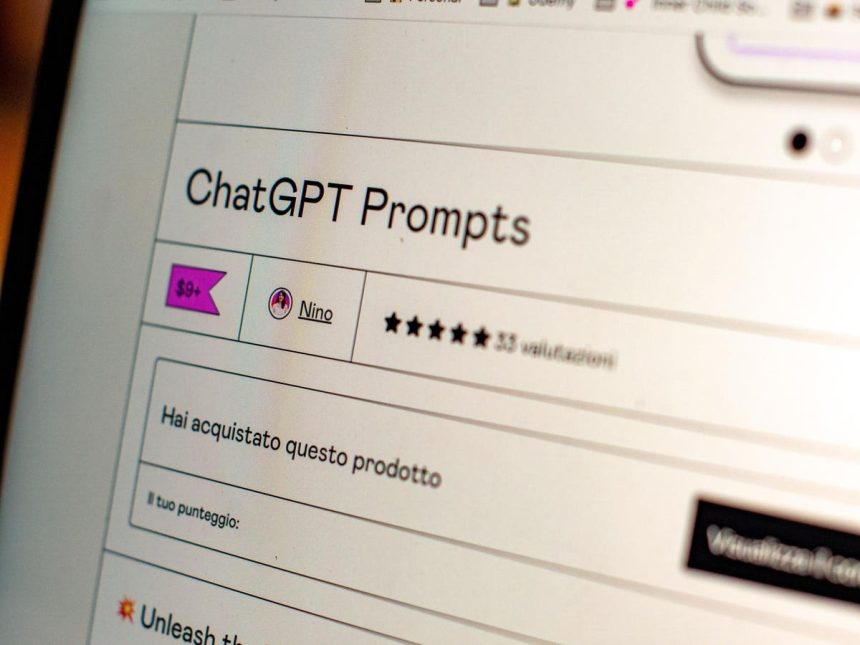Everywhere I turn, offers for ChatGPT prompts abound:
- Grab this ultimate ChatGPT prompt collection.
- Here’s a prompt library template to find the right prompt.
- Steal these ChatGPT prompts to get 10x more work done than your colleagues.
But what, exactly, are ChatGPT prompts? In artificial intelligence, ChatGPT prompts are predefined questions or statements designed to guide AI models like ChatGPT in generating specific content.
People often market prompts as quick solutions for content creation, but as AI consultant and educator Ashley Couto wisely said, “You can buy as many prompt packs as you want, [but] they’re never going to help you master ChatGPT…. It’s putting lipstick on a pig. They’re good for a day-one experiment, but it takes a lot more than that to nimbly and creatively use these tools.”
In this article, I’ll explore why pre-designed ChatGPT prompts often fall short for content creators and reveal the underlying complexities and limitations of relying solely on these tools. In my next article, I’ll share an approach for what to do instead to guide you toward more effective, creative ways for using ChatGPT in content creation.
Until then, let’s consider why ChatGPT prompts often fall flat for content creators.
1. Prompts are starting points, not magic bullets
Many people think prompts are designed to deliver the perfect content. The truth is that prompts are mere starting points for the AI model. The outputs you get depend on the quality and specificity of your inputs.
For example, here’s a ChatGPT prompt from one of the many mega collections:
“Assist me in crafting a compelling value proposition for [product or service], highlighting its unique selling points and benefits to the target audience.”
The prompt, as is, may lead to vague and untargeted results because ChatGPT needs to know, at a minimum:
- What your product is
- What competitors say about competing products
- What your unique selling points are
- Who your audience is.
I tried this prompt for a service I’ve been thinking about offering.
In response, ChatGPT first outlined five unique selling points and five benefits, even though that’s not what I asked for. I’m not sharing those elements here because the result—the value proposition—is more important.
I wouldn’t use that AI-generated content in any public forum other than this one. Why? Because it severely lacks specificity:
- Flexible and tailored editing solutions—what does that mean?
- Your unique business needs—such as?
- Across various industries—what industries?
- Personalized editing—what does that mean?
- We, we, we—I’m a solo practitioner; “we” sounds like delusions of grandeur.
The failure of this prompt to generate the desired content illustrates the need for clear, specific instructions tailored to the particular content or audience.
2. Generic prompts deliver generic results
Some people may mistakenly believe that general prompts will generate specific, targeted content—not true, as you saw in the previous “fractional editing” example.
Without specific instructions or context, the model will generate content that’s too broad or misses the nuances of your subject matter.
Here’s an example from another ChatGPT prompts guide.
“Provide a list of FAQs related to my fractional editing service.”
Again, the results are generic.
- Who can benefit? In the last sentence under that question, I see the word “anyone.”
- How are services priced? It depends.
- What types of editing? A wide range.
- How do I get started? Contact us.
Even the answer to the first question, “What is fractional editing,” is so generic as to render it useless. The answer is also wrong, at least in my definition, because fractional editing is performed by a fractional editor, who contracts to serve as editor for multiple organizations, just as a fractional CMO or COO serves in those capacities for various companies.
This example demonstrates the importance of providing an AI model with detailed, specific instructions and feedback.
So, while the FAQ prompt might inspire you and point you on your way, it won’t help you churn out content quickly.
3. One-size-fits-all prompts exist, but not for content creation
Fed by an overabundance of ChatGPT prompt ebooks, lists, and guides, there’s a growing misconception that universal prompts exist and that you can apply them across the content marketing ecosystem.
But, as you’ve seen, pre-made prompts don’t align with your specific business goals or target audiences. You can use them as a starting point or, as Ashley Couto said, a one-day experiment. But don’t expect a finished product.
To get at a finished product, expect to refine iteratively, giving the AI additional instructions as you hone your content. I’ll say more about how to go about that soon.
4. Prompts fail to address ChatGPT’s limitations
In my forays across the web, I’ve seen plenty of articles that may lead some to believe that ChatGPT knows everything and can create any content fast.
Although ChatGPT is an innovative tool with significant potential for content creation, the reality is that the model has inherent limitations, such as a lack of expertise in your domain, the potential for bias, and an inability to access real-time information, all of which can affect generated content—even with a well-crafted series of prompts.
The model might also generate content that closely resembles existing content, posing plagiarism concerns, or it may fail to capture your brand’s unique voice.
These challenges and the others listed here highlight the need for human oversight and refinement.
Lack of domain expertise
ChatGPT can generate content across various subjects but needs the more nuanced understanding a human expert in your field has. This limitation can lead to content that misses the subtleties of your industry, potentially reducing its accuracy or relevance.
Pervinder Johan, in his Forbes article on the potential of AI and domain-specificity, uses his field—supply chain—as an example.
“It will take much more than slapping a machine learning overlay atop a transportation management system,” he said. “An effective AI solution for the supply chain would need to be fine-tuned with vast amounts of highly specific data and highly technical, specific human insights.”
Potential for bias
The model may inadvertently introduce biases initially present in its training data, leading to content that might not mesh with your brand’s values or target audience, causing misunderstandings or misrepresentations.
For instance, because ChatGPT was trained on data with gender biases, we know it could unintentionally generate content that reinforces stereotypes, as Amazon found when it discontinued its AI recruiting tool because it showed bias against women.
The inability to access real-time information
ChatGPT’s training data is current as of September 2021. The AI tool can’t access real-time information or developments after the training cut-off date. If you’re a content marketer using ChatGPT for brainstorming or researching current events, you might find the data it retrieves disappointing.
You can use ChatGPT plug-ins to access more current information, but that’s the subject of a future article. If you’re interested in the topic, follow me to be notified when I post new articles.
Difficulty capturing brand voice
Crafting content that looks and sounds like your brand will require iterative refinement and human oversight, especially if you use an open AI model like ChatGPT. Understanding that “AI doesn’t know anything about you,” Jasper, an AI writing tool, developed templates and training to help content marketers capture the unique brand voice of their companies.
Potential for plagiarism
There’s a risk that the model might generate content that closely resembles existing content, posing plagiarism concerns. Grammarly, an AI-assisted writing tool, launched a plagiarism detector to combat the potential for plagiarism in AI-generated content.
Ethical concerns
In her recent Letter from the Editor, Amanda Zantal-Wiener, editor-in-chief of Search Engine Journal, shared how she responded when a stranger asked if she ever used ChatGPT for brainstorming new ideas for her weekly letter.
“I was horrified,” she said. “‘Are you asking me, the editor-in-chief of a tech business publication, if I’ve used ChatGPT to write for me? Absolutely not.’”
When she realized the person was suggesting ChatGPT brainstorm for her, not write, she relaxed—but just a little. “Okay, they weren’t recommending plagiarism,” she said. “But it gave me pause nonetheless.”
Your readers might feel the same pause—at least until generative AI gains a foothold among content creators—because using AI to create content raises ethical questions around authenticity, transparency, and, as several people have written to tell me about, the potential of AI to replace human writers.
As a writer who uses ChatGPT for research, brainstorming, and productivity purposes, I’m not concerned, but your readers may be.
5. Prompts further the illusion of a creative AI
The illusion of AI creativity exists whether using prompts or not because ChatGPT can produce content that, at a glance, appears highly creative. It can write poems and stories and generate ideas that mimic human creativity, but its creativity is based on patterns and data, not personal experiences and emotions.
Adding prompts to the mix furthers the illusion because the word “prompt” could signal—especially to novice users—that a single prompt is all they need for ChatGPT to replicate human creativity without guidance and generate a creative masterpiece that rivals the best humanity has to offer.
And why not?
If we want our significant other to do something, we prompt them and generally expect them to do it. If we’re using our computer’s command line, we enter a prompt at the blinking cursor, and the machine performs as instructed.
Generative AI is different because it takes many prompts—inputs, really—to get anywhere close to the result we, as content creators, want.
I don’t imagine computers would have taken off outside of the development community if users had to prompt them toward usable outputs repeatedly. That’s coming for generative AI, but we’re not there yet.
This misconception about AI creativity may also stem from our need to understand the nature of creativity itself and where creativity comes from. Human creativity doesn’t come from a computer. It comes from a complex interplay of emotions, experiences, cultural influences, and individual perspectives.
While ChatGPT can mimic some aspects of creativity, it’s not human. It lacks personal experiences, feelings, and a nuanced understanding of human culture. Chat GPT’s “creativity” arises instead from the patterns it discovers in user queries and training data.
This illusion of AI creativity challenges our understanding of what creativity means. It opens up debates about authenticity, originality, and the role of AI in creative fields.
If not ChatGPT prompts, then what? A guided approach
My recommendation? Forget “prompts.” Instead, think “interviews and instructions.”
When using ChatGPT, converse with it. Interview and instruct it, asking questions, probing for more information, and requesting that it dive deeper and deeper into an unwieldy sentence, unclear paragraph, or complex topic.
In my next article, I’ll present a five-step, guided approach to using ChatGPT for content creation success. Follow me to be notified when that piece goes live.
Read the full article here










